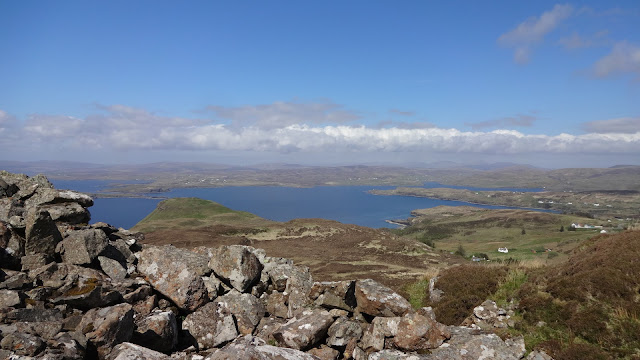Dun Ard an t’sabhail
NG318333
Visited 9/5/17
Directions:
We parked beside the road near the large barn at the hairpin
bend. Room for a couple of cars well
tucked in, while still allowing for passing traffic.
Our visit was during an unusually long, dry spell – could be
quite a boggy trek normally. To avoid
detours and climbing fences (never a good idea – a) there is usually barbed
wire in top and b) fencing is very expensive and the more people climb it the
more it gets damaged) – take the gate in front and to the right of the large
barn and follow the fence line up, through a second gate. Please ensure gates are closed behind
you. The broch is situated on a high
rocky crag best approached from the left.
Follow a break in the cliffs and clamber up the steep grassy slope to
the summit.
The broch:
Although the broch is in quite a ruinous state, it still retains
sufficient of its structure to merit a visit.
The broch is situated in an easily defended spot on top of a rocky knoll
with extensive and beautiful views all around.
 |
| First view |
 |
| Amazing views |
 | |||||||
| David admiring the views |
A pile of tumbled stones in the northern sector is said to be the remains of a cairn.
 |
| https://canmore.org.uk/site/11076/skye-dun-ard-an-t-sabhail |
 | ||||||||||||||||||||||||||||||||||||||||||||||||||||||||||
| Guard Cell |
The entrance and one “guard cell” to the left of the entrance are easily identified and traces of a second cell are indicated by a hollow within the walls on the other side of the entrance.
Canmore mentions a scarcement, noted in 1921 but we were unable to find any evidence of this.
Meaning of Ard an t'sabhail:
Most Duns or brochs are simply named after the nearest
settlement. Some of today’s names are
derived from Gaelic while others are derived from Norse – both languages being
rather later than the dates when the duns were constructed. We have no way of
knowing what their original names were or if any of the modern names bear any resemblance
to the original names.
He also comments that the name could be derived from Há-fjall – high fell in Norse. Local Gaelic speakers have informed me that the word Sàbhail can mean salvation or protection
All interesting ideas – Several people have proposed the idea that brochs were used for storing grain (eg.Harrison and Maher) which fits in nicely with the concept of Sabhail being from Sabhal = barn but the concept of a place of safety or protection (Sàbhail = to save) is fits in with the idea of the broch being a defensive structure and place of refuge.
References
Forbes, Alexander Robert, (1923) Place names of Skye and Adjacent Islands
(digitsed by SMO http://www.smo.uhi.ac.uk/files/PDFs/00915325_Place_Names_of_Skye.pdf
Harrison, Ramona and Maher, Ruth A. (2014) Human Ecodynamics in the North Atlantic: A
Collaborative Model of Humans and Nature through Space and Time,
Lexington Books
Lexington Books

No comments:
Post a Comment